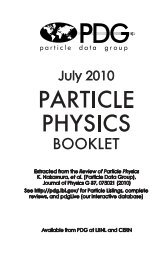30. Passage of particles through matter 1 - Particle Data Group
30. Passage of particles through matter 1 - Particle Data Group
30. Passage of particles through matter 1 - Particle Data Group
You also want an ePaper? Increase the reach of your titles
YUMPU automatically turns print PDFs into web optimized ePapers that Google loves.
<strong>30.</strong> <strong>Passage</strong> <strong>of</strong> <strong>particles</strong> <strong>through</strong> <strong>matter</strong> 5<br />
limit the projectile velocity becomes comparable to atomic electron “velocities”<br />
(Sec. <strong>30.</strong>2.3), and at the upper limit radiative effects begin to be important<br />
(Sec. <strong>30.</strong>6). Both limits are Z dependent. Here Tmax is the maximum kinetic<br />
energy which can be imparted to a free electron in a single collision, and the other<br />
variables are defined in Table <strong>30.</strong>1. A minor dependence on M at the highest<br />
energies is introduced <strong>through</strong> Tmax, but for all practical purposes 〈dE/dx〉 in a<br />
given material is a function <strong>of</strong> β alone.<br />
For heavy projectiles, like ions, additional terms are required to account for<br />
higher-order photon coupling to the target, and to account for the finite size <strong>of</strong> the<br />
target radius. These can change dE/dx by a factor <strong>of</strong> two or more for the heaviest<br />
nuclei in certain kinematic regimes [7].<br />
− dE/dx (MeV g −1 cm 2 )<br />
10<br />
8<br />
6<br />
5<br />
4<br />
3<br />
2<br />
1<br />
0.1<br />
0.1<br />
1.0 10 100 1000 10 000<br />
βγ = p/Mc<br />
0.1<br />
0.1<br />
H 2 liquid<br />
He gas<br />
Fe<br />
Sn<br />
Pb<br />
1.0 10 100 1000<br />
Muon momentum (GeV/c)<br />
1.0 10 100 1000<br />
Pion momentum (GeV/c)<br />
1.0 10 100 1000 10 000<br />
Proton momentum (GeV/c)<br />
Figure <strong>30.</strong>2: Mean energy loss rate in liquid (bubble chamber) hydrogen,<br />
gaseous helium, carbon, aluminum, iron, tin, and lead. Radiative effects,<br />
relevant for muons and pions, are not included. These become significant for<br />
muons in iron for βγ > ∼ 1000, and at lower momenta for muons in higher-Z<br />
absorbers. See Fig. <strong>30.</strong>23.<br />
Few concepts in high-energy physics are as misused as 〈dE/dx〉. The main<br />
problem is that the mean is weighted by very rare events with large single-collision<br />
June 18, 2012 16:19<br />
Al<br />
C







